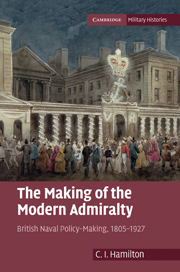Book contents
- Frontmatter
- Contents
- List of tables
- Preface
- Introduction
- 1 Lord Barham's Admiralty: 1805
- 2 Admiralty reform, 1806–1835
- 3 Decision-making at the Admiralty, c. 1806–1830
- 4 Admiralty administration and decision-making, c. 1830–1868. The Graham Admiralty
- 5 The Admiralty reformed again: context and problems, 1868–1885
- 6 Administrative and policy-making responses, c. 1882 onwards
- 7 Fisher and Churchill, and their successors, 1902–1917
- 8 The Naval Staff, planning and policy
- 9 Lord Beatty's Admiralty
- Conclusion
- Appendix 1 First Lords, First Sea Lords and Permanent Secretaries, 1805–1927
- Appendix 2 Acronyms and definitions
- Manuscript sources and select bibliography
- Index
4 - Admiralty administration and decision-making, c. 1830–1868. The Graham Admiralty
Published online by Cambridge University Press: 03 May 2011
- Frontmatter
- Contents
- List of tables
- Preface
- Introduction
- 1 Lord Barham's Admiralty: 1805
- 2 Admiralty reform, 1806–1835
- 3 Decision-making at the Admiralty, c. 1806–1830
- 4 Admiralty administration and decision-making, c. 1830–1868. The Graham Admiralty
- 5 The Admiralty reformed again: context and problems, 1868–1885
- 6 Administrative and policy-making responses, c. 1882 onwards
- 7 Fisher and Churchill, and their successors, 1902–1917
- 8 The Naval Staff, planning and policy
- 9 Lord Beatty's Admiralty
- Conclusion
- Appendix 1 First Lords, First Sea Lords and Permanent Secretaries, 1805–1927
- Appendix 2 Acronyms and definitions
- Manuscript sources and select bibliography
- Index
Summary
The Graham Board of Admiralty
Some things remained the same at the Admiralty Board after 1832. There was still a noticeable change of pace as the seasons progressed, most obviously after the ‘Glorious Twelfth of August’, the start of the shooting season, when there might be barely a Board quorum. Overall, though, the Lords Commissioners were more loaded down than before. Some of the reforms had cut work. There was less repetitive decision-making; and board no longer wrote to board – an eighth of the total correspondence, according to Graham's calculation. But the gains were not absolute. Repeated decisions had often been decisions that were nodded through: now their Lordships had to pay close attention to the issues involved, and not assume that they had been studied already. And business once dealt with between boards could reappear in different guises. Admiralty Board meetings in the 1830s were not much longer than they had been, but all the lords now had extensive further duties. After a Board meeting of a couple of hours, the superintending lords had regularly to walk down to Somerset House for a heavy afternoon personally supervising the work of the Principal Offices. Any serious problems met there would have to be noted, and submitted for the consideration of the next Board meeting – in essence little different from the old system of referring business from the Navy Office to the Admiralty for a decision, but here too the task was now focused on the Lords Commissioners.
- Type
- Chapter
- Information
- The Making of the Modern AdmiraltyBritish Naval Policy-Making, 1805–1927, pp. 116 - 148Publisher: Cambridge University PressPrint publication year: 2011

